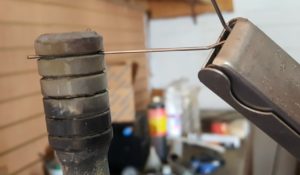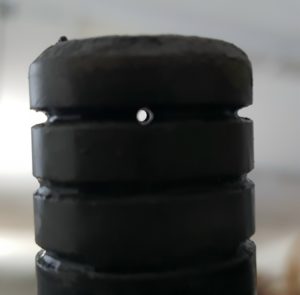I recently tried to get strip casting working on my Monotype Composition Caster but gave up after several failures. One suspect was the pump; the strip-casting moulds use a different pump than composition and display casting, and I had never used this particular pump before. One possible cause of (some of) my strip-casting problems could be explained by poor pump performance.
I’ve converted my caster back to its type-casting configuration, and have since been taking a close look at the pump. My caster normally uses an English Monotype design pump which has one-way valves on both the inlet and outlet of the pump chamber. The pump for strip casting was, however, a Lanston (American-made) pump, where the inlet to the pump chamber is opened or closed solely through the position of the piston in the cylinder: When the piston is at the top of its travel, the inlet port on the side of the cylinder aligns with the gap between the two bottom-most rings of the piston, and from there molten metal can enter the cylinder through two small holes drilled from this gap to the center of the piston. Once the piston starts its downward stroke, the second ring closes off the inlet port so metal can no longer enter (or, more importantly at this point, exit) through this port. The molten metal is instead forced out the bottom of the pump into the mould cavity, where it solidifies almost instantly. When the piston rises again, the now-solid metal cannot flow back into the pump chamber, so a vacuum forms there, and this vacuum is not relieved until the piston returns to the top of its stroke, again opening the inlet port.
These holes in the piston end are crucial to pump operation; if they are clogged the only metal that can enter the pump chamber is whatever can leak by the bottom piston ring.
Today I had a close look at this piston, and found that I could barely even tell where the holes were. I cleaned them out by putting the piston in a vise, using a torch to melt any type metal on the head of the piston, and using a set of welding torch tip cleaners to clean out these holes. I started with the finest cleaning wire and worked my way up until the hole would not open up any further, at which point I had run out of slag to clean out and was now trying to remove the metal of the piston itself.
Based on the size of the largest tip cleaner that would fit, it appears that these holes are about a #56 drill, or about 0.047″ (1.2mm) in diameter.
I suspect that many Monotype owners don’t even know about these holes. The need to keep them clear certainly never came up at Monotype University.



Leave a Reply